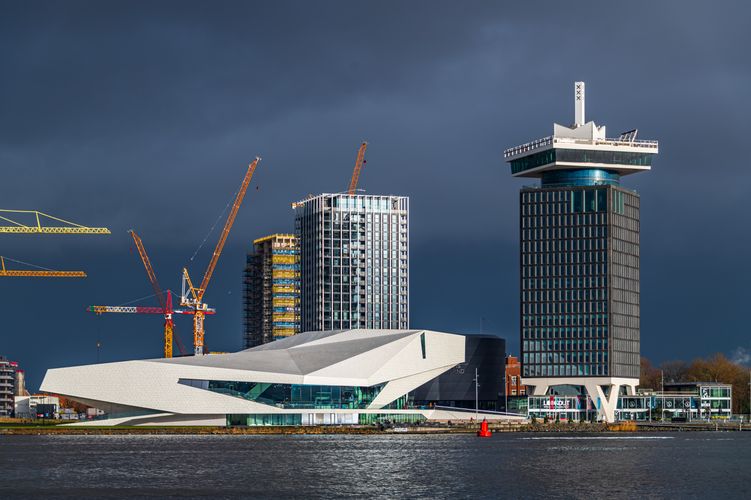
Photo by Bobby Born
This is a post by a talented urban designer and architect Prisca Arosio from MELITA STUDIO.
“Amsterdam is in demand, increasing in size by around 11,000 inhabitants per year. The City of Amsterdam wants to facilitate this growth and at the same time reduce pressure on the housing market. By 2025, its goal is to enable the construction of 52,500 homes within the city boundaries” — City of Amsterdam official website.
This article lists some very unique but interesting residential developments along the waterfront which were built only in the last 50 years in the city of Amsterdam. Explore the “new” city development and have a break for a coffee or lunch. It would make you feel like you are part of Amsterdam's upcoming eye opening attractions.
Places to go, projects to check out
-
Borneo Island: A harbour and a docking area have been transformed by urban designers West 8 into a low-rise residential district (1993-2000). Take a walk around the town’s distinctive urban landmark. Check out exciting home facades in Stokerkade street and visit the BAC Borneo Architectuur Centrum where you will learn about the history of the district and its transition.
-
Java Island: This district is another harbour renovation project which was turned into a residential area too (1991-2000). You can find multiple small pedestrian bridges stitching the neighbourhood together over the canals full of compact boats. Complete your visit with the viewing of the newly built Hotel Jakarta designed by Amsterdam based architectural office called Search. Read more about the urban design of Java Island here.
-
Funenpark: The neighborhood was a former railway station marshalling yard that was transformed into a new urban quartier in 2011. It is interesting to see how the urban masterplan integrates the landscape design (by Landlab) and housing blocks and villas by 6 different architectural offices. Take a walk in Czaar Peterbuurt, a small street full of boutiques and coffee places.
-
Houthavens: The former port area is being developed into a residential quartier that is formed by low rise buildings including an iconic high rise building called Pontsteiger. Most of the residential blocks have canal views that resemble traditional Amsterdam house typologies. You can view the site plan at the district's official website. You can stop by at Vessel cafe to observe the waterfront and the ever changing skyline of the “new” Amsterdam.
-
NDSM: Although it is still under construction, the neighborhood is accessible by ferry from Pontsteiger and Central station. During the 19th century, this area was one of the biggest shipyards in the world. It is now being developed into a dense residential area with mixed-use functions. What makes this district unique is the amount of large towers and wide streets profiles. Have a walk in the old shipyard NDSM-werf where you can find many creative local studios. At last, check out the coffee place Noorderlicht, a greenhouse turned into a café with a nice panoramic view over the city!
Read
-
Visit Arcam (Architecture centre of Amsterdam) to see architecture’ exhibitions and get more information about the urban history of Amsterdam.
-
Listen to the urban design and social history of the Bijlmer district. This district was designed by modernist architects to be a “city of the future” in the 1960. Now, it's one of the most diverse areas in The Netherlands: Episode 01 and Episode 02.
-
Have a look at the Dewarren which is the first cooperative housing project in Amsterdam that designs and builds its own real-estate by the residents. The Dewarren project aims to realize 36 apartments that are sustainable at affordable prices.
Organizations
Dutch urban design offices:
-
Karres en Brands; This office focuses on sustainable master planning mostly in the Netherlands, Germany and Russia.
-
Bura; Bura is an upcoming urban design and research office from Amsterdam. According to their website, BURA stands for Designing sustainable urban environments alongside research and design that promotes Urban craftsmanship and collaboration.
-
Urhahn; Urhahb focuses on urban strategy and urban design works in the netherlands and dutch speaking cities in belgium.
-
FABRICations; Fabrications office works on Architectural design, Urban Plans and Regional strategies for Resilient Cities. The office focuses on innovative design solutions for the relevant issues of our current society.
Organizations:
-
Pakhuis de zwijger; This Amsterdam ‘public meeting place’ holds conferences, lectures, discussions about cities and many more topics (Designing cities for all).
-
Archined; Check this Archined website to view updates about the latest dutch projects, local competitions, conferences, exhibitions and much more (Available only in Dutch language).
-
Architour; Architour organizes architecture tours for groups in Amsterdam including other cities in the Netherlands such as Rotterdam.

MELITA STUDIO
Melita studio is an open office that works in the field of architecture, urban design and architecture. It is distinguished for a research-driven process.
Melita studio is founded by Prisca Arosio and she collaborates with numerous people and entities. Prisca Arosio is an urban designer, researcher and Dutch registered architect. Her interest in urban strategy focuses on public spaces and their social interaction. Prisca holds a MSc in Architecture, Building and Planning from the Technical University of Eindhoven and a BSc in Architecture from Politecnico di Milano. She worked in diverse Amsterdam-based offices. She got experienced in landscape architecture and architecture projects at Kettinghuls office and urban design approach at Basta urbanism. In addition, she participated in the organization of the AA visiting school, the house of politics 2018 and she was part of the jury panel ‘Tamayouz award’ (architecture competition) in 2018/2019/2020.


